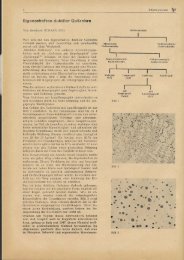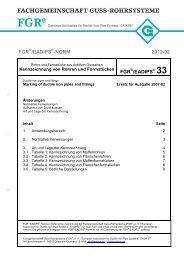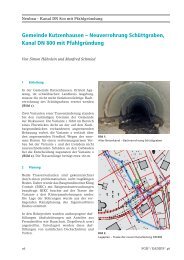Download PDF file
Download PDF file
Download PDF file
- TAGS
- download
- 81.169.135.155
Create successful ePaper yourself
Turn your PDF publications into a flip-book with our unique Google optimized e-Paper software.
A DN 200, PFA 40 pressure pipeline for a drinking water power station<br />
Generating electricity by water power – An important<br />
contribution to the phasing out of atomic energy<br />
by Andreas Schütz<br />
1 Introduction<br />
Thanks to the topographical conditions in Switzerland,<br />
there is still a vast potential for the<br />
environmentally-friendly generation of electricity<br />
by hydroelectric power, especially in the<br />
mountainous regions. What is more, this form of<br />
electricity generation has for many years now,<br />
been actively encouraged by the federal government<br />
by the provision of financial support.<br />
The decision in May 2011 by the Swiss Federal<br />
Council to completely phase out atomic energy<br />
by 2034 is now creating an entirely new situation.<br />
In releases to the media, the federal<br />
govern ment has stated that it is planning to<br />
make the development of water power its first<br />
priority. Other important elements of its future<br />
energy policy are the saving of electricity,<br />
improved efficiency and above all efforts relating<br />
to renewable energy sources.<br />
2 The promotion of water power<br />
A revision of the Swiss Energy Law is expected<br />
as a result of the Federal Council’s decision.<br />
Even before this decision, the Energy Law laid<br />
down an increase of at least 5,400 GWh in the<br />
generation of electricity from renewable energy<br />
sources by 2030. There is now expected to be a<br />
substantial upward adjustment of this figure.<br />
The existing Energy Law already includes a raft<br />
of measures for promoting renewable energies<br />
and for increasing efficiency in the electricity<br />
sector. The main measure in this case has<br />
been the cost-covering remuneration for feedin<br />
to the grid (CRF) for electricity from renewable<br />
energy sources. Around 247 million Swiss<br />
francs per annum has been made available to<br />
offset the difference between the remuneration<br />
42<br />
and the market price. To date, the cost-covering<br />
remuneration is provided for the following<br />
energy sources:<br />
■ water (i.e. hydroelectric) power<br />
■ photovoltaic energy<br />
■ wind power<br />
■ geothermal energy<br />
■ biomass and waste from biomass.<br />
Depending on the energy source, the remuneration<br />
is payable for 20 to 25 years.<br />
3 Green electricity from drinking water<br />
power stations<br />
A principal aim of the federal government’s new<br />
energy strategy is to increase energy efficiency.<br />
In this respect, electricity generated by drinking<br />
water power stations is particularly energy<br />
efficiency because, as well as serving their main<br />
purpose of supplying drinking water, the drinking<br />
water pipelines also generate environmentally-friendly<br />
electricity. The advantages to the<br />
operator are obvious. The electricity generated<br />
by drinking water power stations is produced<br />
locally, and the environment and the water cycle<br />
remain virtually unaffected. What is more, an<br />
important contribution can be made to achieving<br />
the government’s aims at a relatively low<br />
cost (Fig. 1).<br />
The production of electricity does not impair<br />
the quality of the drinking water. Also, in the<br />
assessment of the VUE (Swiss Association for<br />
Environ mentally Sound Energy), the environmental<br />
pollution caused by drinking water<br />
power stations can hardly be measured. The<br />
energy produced therefore ranks as green electricity<br />
and can be sold as such.<br />
FGR® / EADIPS® 46
















